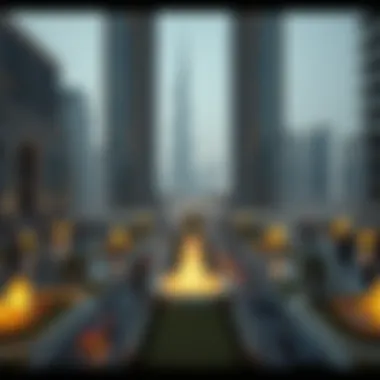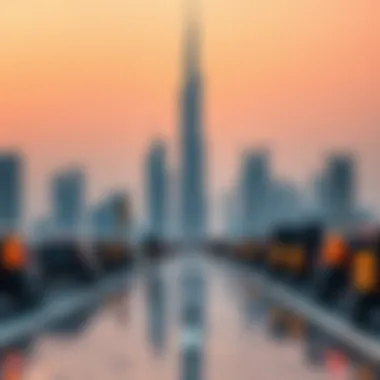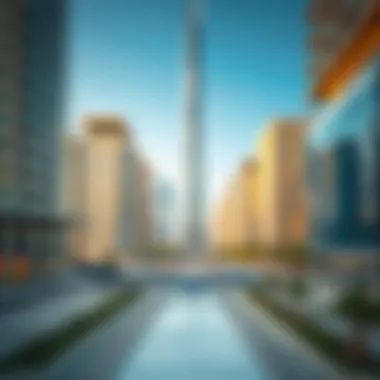Dubai 2040: Urban Development and Sustainability Vision


Intro
In recent years, Dubai has emerged as a beacon of innovation and progress, catching the eyes of investors, builders, and tourists around the globe. With ambitions scaling as high as its iconic skyscrapers, the city has set forth an expansive roadmap stretching to the year 2040. This vision entails not just architectural marvels, but a commitment to sustainability, technology integration, and an overall enhancement of the lifestyle offered to its residents.
Dubai is not just about luxury; it represents a lifestyle that many aspire to achieve. It’s a melting pot of cultures and ideas, and the forthcoming years promise to intensify this vibrant mix. As the local government unveils its plans, the implications for various sectors—real estate, technology, and urban development—become increasingly evident. This article aims to dissect these developments, providing insights into how they may shape the future for investors, residents, and the global community at large.
Preface
The vision for Dubai by the year 2040 encompasses a significant shift in urban planning, infrastructure, and technology, all molded to enhance the quality of life for its residents while boosting the city’s global status. As we delve into this ambitious framework, it becomes essential to grasp the multifaceted objectives set forth by the government and various stakeholders. Understanding the lay of the land—not just figuratively, but in terms of the economic and social topography—is critical.
Dubai’s government aims to strike a balance between rapid development and sustainable practices. With a rapidly growing population, it is paramount to anticipate the challenges that accompany urbanization. Considering the aspirations of investors, whether they be foreign landlords or local business tycoons, it’s clear that the city is out to make a statement.
This article will explore how these initiatives can potentially reshape the lifestyle of residents and present unique opportunities for investors and real estate professionals. Insights into urban development, sustainable architecture, and advanced transportation systems will be highlighted as cornerstones of this ambition.
By the end of our discussion, readers will not only appreciate what Dubai aims to achieve but also understand the ramifications of this evolution on various sectors—spanning real estate, technology, and the economy at large. As we navigate through the various promising aspects of Dubai's future, the importance of adopting a forward-thinking mindset cannot be overstated.
Conceptual Framework for Dubai
The conceptual framework for Dubai 2040 is not just a roadmap; it is a blueprint that encapsulates the ambitions and aspirations of the city as it gears up to tackle future challenges while maximizing opportunities in an ever-changing global landscape. This framework lays down a foundational vision that drives initiatives in urban development, sustainability, transportation, real estate, and technological integration. By aligning various stakeholders—from policymakers and investors to residents and innovators—Dubai aims to create an ecosystem where collaborative efforts can flourish.
A well-defined conceptual framework serves several key purposes:
- Provides Structure: It organizes complex ideas into manageable components, allowing for clarity in understanding and execution.
- Guides Policy Development: Policies are shaped and aligned with the overarching goals of economic growth, social well-being, and environmental stewardship. This is especially crucial given the diverse demographics of the city.
- Enables Effective Communication: The framework articulates Dubai's mission to both local and international audiences, fostering a sense of transparency and trust among stakeholders.
- Encourages Innovation: By identifying the critical areas for development, it promotes creative solutions, attracting talent and ideas from all over the globe.
In envisioning the future, Dubai relies heavily on strategic government objectives and a strategic roadmap that ensures all efforts are synchronized to achieve the collective vision.
Government Objectives
The government objectives for Dubai 2040 revolve around key themes that are imperative for the city’s evolution:
- Sustainability: A core objective centers on embedding sustainability into every aspect of city planning and development. By prioritizing green initiatives, the government aims to minimize the ecological footprint of urbanization.
- Enhanced Quality of Life: Ensuring that residents enjoy a high quality of life is paramount. This encompasses everything from accessible public spaces to cultural experiences that enrich community ties.
- Global Competitiveness: By fostering an environment conducive to international business and investment, Dubai aspires to strengthen its position as a global economic hub.
- Cultural Diversity: Celebrating multiculturalism is essential. The government is committed to creating inclusive spaces that honor the diverse backgrounds of its residents, thereby enhancing social cohesion.
The objectives can be summarized as part of a long-term vision that is adaptable and forward-thinking, addressing both the immediate needs and the anticipated challenges of tomorrow.
Strategic Roadmap
The roadmap that outlines Dubai’s transformation into a global leader by 2040 is both detailed and dynamic. It is crafted to reflect the city's distinctive context and to accommodate flexibility as circumstances evolve. Key milestones within the roadmap include:
- Infrastructure Upgrades: Modernizing existing infrastructure to support accelerated growth while improving urban mobility and connectivity.
- Green Building Policies: Implementing regulations that champion eco-friendly architectural practices and sustainable energy use in new developments.
- Technology Integration: Deploying smart city technologies that streamline services and engage citizens in daily governance, enhancing the interactions between residents and their environment.
- Investor Engagement Programs: Encouraging foreign and local investment through targeted campaigns that highlight growth sectors and emerging opportunities.
- Educational Initiatives: Establishing partnerships with educational institutions to build a workforce that is equipped for the new jobs and sectors that will emerge.
"The road to Dubai 2040 is paved with opportunities for innovation and growth, driven by a collective desire to create a vibrant city for generations to come."
In essence, the strategic roadmap is a comprehensive guide that secures the vision for Dubai's future while promoting ongoing dialogue among diverse stakeholders. Each element within the framework interacts synergistically, ensuring that progress in one area supports advancements in another, ultimately leading to a harmonious and thriving urban landscape.
Urban Development Initiatives
Urban development initiatives form the backbone of Dubai's ambitious plans for 2040. As the city looks toward a future that balances growth with sustainability, the importance of revamping urban spaces and infrastructure cannot be overstated. These initiatives not only enhance the living experience for residents but also attract investors and improve the overall economy. Let’s delve deeper into the two main aspects shaping urban development: revamping infrastructure and sustainable architecture.
Revamping Infrastructure
Revamping infrastructure is a crucial component of Dubai's plans. The city has long been known for its avant-garde structures and luxurious lifestyle, but continuous growth necessitates a reevaluation of existing frameworks. Upgrading roads, bridges, and public utilities not only allows smoother traffic flow but also promotes a more efficient use of resources.
The benefits of this infrastructure overhaul go beyond mere aesthetics. Improvements can lead to a reduction in commute times, enhance safety, and reduce maintenance costs in the long run. Moreover, it's essential to incorporate smart technology into the infrastructure. For example, intelligent traffic management systems that can adapt to real-time traffic conditions reduce congestion and maximize efficiency.
"A solid infrastructure serves as the foundation upon which cities thrive, driving innovation and development."
Key points in the revamping process include:
- Smart Roads: Integration of sensors and IoT technology to manage traffic flow.
- Eco-Friendly Utilities: Renewable energy sources powering public services to minimize ecological footprints.
- Public-Private Partnerships: Engaging private sector investments to undertake large-scale projects.
Sustainable Architecture
Sustainable architecture is another stone in the mosaic of Dubai's development strategies. Traditional building methods are being reassessed to decrease environmental impact while maintaining aesthetic appeal. This new trend embraces sustainability not just as a buzzword but as a core principle driving construction and design practices.
Innovations in sustainable architecture include:
- Energy-Efficient Buildings: Utilizing solar panels and green roofs to manage energy consumption effectively.
- Water Conservation Systems: Advanced plumbing systems designed to minimize water waste while maintaining functionality.
- Green Spaces: Inclusion of parks and gardens in urban planning to foster biodiversity.
These architectural practices play a pivotal role not only in ensuring environmental harmony but also in attracting eco-conscious buyers and investors. By promoting energy savings and a healthier lifestyle, Dubai positions itself as a leader in sustainable urban living, making it a more attractive place for future generations.
Transportation Advancements
Transportation is the lifeblood of any modern city, and in the case of Dubai, it's high on the agenda as the city gears up for its ambitious plans for 2040. The enhancements in this sector are not merely about getting people from point A to point B; they reflect a broader vision of a thriving, interconnected metropolis that values efficiency, sustainability, and innovation. In this narrative, we shall dive deep into two critical components driving the future of transportation in Dubai: Smart Mobility Solutions and the Integration of Public Transport.


Smart Mobility Solutions
Smart Mobility Solutions encapsulate the integration of advanced technologies, data analytics, and user-centered approaches to create a seamless transport experience. With the rapid advance of technology, mobility solutions are evolving, and Dubai aims to stay ahead of that curve.
In essence, these solutions promise to ease congestion, reduce carbon footprints, and enhance the overall travel experience for residents and visitors alike. For instance, systems that utilize artificial intelligence can optimize traffic flow by adjusting stoplight patterns in real-time based on vehicle density. Imagine waiting at a red light less often because the system knows when traffic is thick, effectively reducing idle time and emissions.
Moreover, autonomous vehicles are on the horizon, which would revolutionize travel. Picture a fleet of smart cars buzzing around, adjusted to maintain efficiency, eliminate the need for massive parking structures, and provide a more user-friendly experience. These vehicles could be hailed on-demand through mobile apps, making step away from traditional cab services and reducing the need for private ownership of cars altogether.
Additionally, smart bike-sharing programs, equipped with GPS tracking, could encourage more people to opt for eco-friendly transport. With rental bikes that are easy to find and use, more individuals may choose to cycle rather than drive, contributing to a greener city. This shift is not just beneficial for the environment, but it can also enhance the well-being of the citizens by promoting a healthier lifestyle.
"The future of transportation isn't just about moving people, it's about creating experiences."
Integration of Public Transport
A cornerstone of the transportation advancements in Dubai is the Integration of Public Transport. As the city evolves, connections between various modes of transport will be vital. The aim is to provide residents and visitors with a comprehensive transport network that incorporates buses, trains, water taxis, and the metro.
By streamlining these services, Dubai can ensure that residents can transition from one form of transport to another without unnecessary delays or complications. For example, a resident may take a metro to a bus station which seamlessly connects to a boat ride down the creek.
Equally, integrating schedules will be crucial. Imagine waiting a mere five minutes for the next bus after disembarking from a metro train, without the typical worries of missing crucial connections. Timeliness will be the name of the game.
Moreover, innovative fare systems could introduce an all-in-one card or app that allows travelers to tap into all forms of public transport without additional costs. This convenience can attract more users, reducing the reliance on personal vehicles.
It’s important to note that such advancements come with their set of challenges. Dubai's climate, particularly in summer, poses a significant hurdle. To tackle this, facilities such as shaded stations and air-conditioned buses could incentivize users to opt for public transport even in sweltering heat.
Real Estate Landscape by
The real estate landscape in Dubai by 2040 is crucial in understanding the city’s evolution as a global metropolis. This section delves into emerging property trends, investment opportunities, and market challenges, providing essential insights for stakeholders, including investors, realtors, homebuyers, analysts, and renters. As Dubai positions itself as a nexus of innovation and opportunity, the real estate sector is likely to mirror these changes, adapting and evolving to meet both local and international demands.
Emerging Property Trends
As we look towards 2040, several property trends are making waves in Dubai’s real estate sector.
- Sustainability: Developers are increasingly leaning towards eco-friendly buildings. Solar panels, gray water systems, and energy-efficient designs are no longer optional but expected. This is crucial, especially as the demand for environmentally conscious living rises among buyers.
- Mixed-use Developments: The blend of residential, commercial, and recreational spaces is becoming a blueprint for future projects. Communities that provide live/work/play environments are increasingly attractive.
- Smart Technology Integration: Properties equipped with the latest technology, like smart home systems and IoT connectivity, will be at the forefront. This trend not only enhances convenience but also influences buying decisions.
- Affordable Housing Initiatives: As Dubai aims to attract a more extensive base of residents, affordable housing projects will emerge, catering specifically to middle-income families looking to settle in the city.
These trends are shaping the market's appetite and are essential for prospective investors and homebuyers to understand as they navigate Dubai's real estate landscape.
Investment Opportunities
The investment scene is ripe with potential, particularly as Dubai continues on its path to becoming a global trade hub.
- Commercial Real Estate: With the UAE's economic diversification, industrial and office space investments are set to thrive. The growth of startups and tech firms prompts a need for more commercial spaces.
- Tourism-Based Properties: As tourism integrates with local culture and distinguishes itself, opportunities abound in hospitality and serviced apartments. Investors can capitalize on the consistent influx of international visitors interested in experiencing luxury and authentic local culture alike.
- REITs and Property Funds: Real Estate Investment Trusts (REITs) allow investors to gain exposure to the property market without direct ownership. This is particularly appealing in a booming city like Dubai where property values are on the rise continuously.
- Emerging Neighborhoods: Areas undergoing development outside traditional hotspots are being eyed by investors. With the government's push toward creating new districts, these areas present value opportunities before they fully blossom.
Securing investments in these areas now, especially given the ongoing expansions, might yield significant returns in the long run.
Market Challenges
Despite the opportunities, the real estate sector does face notable challenges that future investors and homeowners must consider.
- Regulatory Framework: Navigating the legal landscape can be tricky, as regulations are changing rapidly in response to market demands and global trends. Keeping abreast of these will be vital for investors looking to capitalize on the market.
- Economic Fluctuations: While the UAE has seen robust growth, external economic factors, such as oil prices and global economic downturns, can impact property values and demand. Investors should remain vigilant and assess how these factors influence the market.
- Supply vs Demand Dilemma: As developers rush to meet demand, over-supply remains a persistent issue, especially in certain segments of the market. This could lead to price corrections, affecting investment viability.
- Financing Obstacles: Access to finance can be a barrier, with banks tightening lending criteria amidst economic uncertainty. Future buyers need to have their financial routes clear and explored thoroughly, ideally seeking expert advice when necessary.
In summary, while the real estate landscape in Dubai by 2040 offers a promising array of opportunities driven by innovation, diversification, and sustainability, it is not without its challenges. Stakeholders must stay informed and strategically navigate these dynamics as they position themselves in a rapidly evolving market.
Technological Integration
The importance of technological integration in Dubai's vision for 2040 cannot be overstated. As a city constantly on the cutting edge, embracing technology not only enhances urban living but also drives economic growth. Integrating advanced technologies into infrastructure, public services, and everyday life presents countless opportunities for improving efficiency, sustainability, and quality of life. This is especially pertinent for investors, realtors, homebuyers, analysts, and renters, as the adoption of smart technologies can significantly shape the real estate landscape and urban experience.
Smart City Innovations
Smart city innovations are at the crux of Dubai's modernization efforts. The city aims to leverage Internet of Things (IoT) devices, big data, and analytics to create an interconnected environment. These technologies will facilitate streamlined operations and optimize resource management. Examples practically illustrate this project. With the targeted deployment of smart traffic signals, congestion can be minimized, while smart waste management systems can optimize collection routes using real-time data.
- IoT Sensors in Public Areas: Applicable for monitoring air quality and traffic flow.
- Smart Lighting: This technology can help reduce energy consumption through adaptive brightness based on natural light.
Such innovations have defined the evolution of urban spaces, driving investor confidence and increasing property values as well. The correlation between technological advancements and economic gain is clear, making it imperative that Dubai stays ahead in this domain.
"A city that integrates technology into daily life offers not only convenience but also fosters an engaging community environment."
Technology in Real Estate
The implications of technological integration extend deeply into the real estate sector. From smart home technologies that enhance living experiences to platforms that facilitate seamless transactions, the sector is transforming at an extraordinary pace. Homebuyers and renters are increasingly looking for properties equipped with modern technologies that align with their lifestyle preferences. For instance, apartments with energy-efficient systems and smart home integration can appeal to environmentally conscious individuals.
Moreover, technologies like virtual reality (VR) and augmented reality (AR) have revolutionized property viewings. Potential buyers can experience properties remotely, giving them a taste of their new lifestyle before purchase. This method not only streamlines the buying process but also enhances market access for realtors.
- Virtual Tours: Allow prospective buyers to visualize spaces from anywhere in the world.
- Blockchain for Transactions: Ensures secure, transparent transactions that reduce fraud risk.
Evidence of such adoption indicates a shifting paradigm in real estate—one that holds potential for higher investment returns and satisfied customers. As technology continues to weave itself into the fabric of the property market, those who adapt will likely reap the benefits, placing them steps ahead of the competition.


Cultural and Lifestyle Enhancements
Cultural and lifestyle enhancements are vital to shaping a thriving, vibrant community in Dubai by 2040. These improvements ensure that as urban development progresses, the social fabric of the city evolves harmoniously. Investing in cultural initiatives entails not just building infrastructure but also fostering a community atmosphere that embraces diversity and creativity.
One of the key elements is the integration of cultural programs that resonate with both residents and tourists. This includes artistic endeavors, festivals, and community gatherings that allow people to express themselves and celebrate their heritage. Enhanced cultural engagement contributes to a sense of belonging amongst residents, while also attracting visitors eager to witness the rich tapestry of experiences that Dubai has to offer. This creates a win-win, enriching the city's landscape for everyone involved.
Furthermore, lifestyle enhancements in Dubai can take shape through increased accessibility to cultural venues and activities. Expanding public spaces, opening art galleries, or even establishing communal gardens encourages communal participation. When the community has spaces to come together, there is a greater chance of building connections and promoting a sense of togetherness.
Promoting Community Engagement
To promote community engagement, Dubai can implement several strategies that involve residents in the decision-making processes affecting their neighborhoods. For instance, regularly scheduled community forums can provide platforms for residents to voice their opinions and concerns while also offering insight into local preferences and desires.
- Public workshops: These can be organized to train residents in cultural practices ranging from traditional crafts to culinary arts.
- Volunteer initiatives: Encouraging residents to contribute their time strengthens bonds within neighborhoods. Programs such as clean-up drives or community art projects enhance shared value systems.
Additionally, digital platforms can facilitate wider participation. By using social media channels and community apps, developers and planners can solicit feedback, thereby ensuring transparency and inclusivity. In essence, involving citizens enhances the overall civic responsibility and pride.
New Cultural Developments
Dubai aims to make significant strides regarding new cultural developments by 2040. Key institutions, such as museums, galleries, and performing arts centers, will be pivotal in this growth. The anticipated Dubai Museum of the Future stands out as an innovative hub combining science, art, and experience. This establishment, along with others, can transform the cultural landscape, making art and history more accessible to all.
Moreover, developing cultural districts dedicated to specific art forms or cultural expressions could significantly enrich local life. Just think of artistic neighborhoods akin to Montmartre in Paris or New York's Harlem, where culture thrives.
In addition, integrating technology into cultural experiences opens doors for interactive displays and virtual art tours. Imagine an augmented reality app guiding users through art exhibits or historical sites while providing rich context and storytelling. This would cater not only to tech-savvy generations but also widen the spectrum of engagement for anyone eager to learn.
Investing in cultural and lifestyle enhancements creates an environment that attracts global talent, boosts tourism, and enhances the quality of life for Dubai’s residents.
Finale
In summary, embedding cultural and lifestyle enhancements into the city's fabric is an essential cog in Dubai's ambitious 2040 vision. Through promoting community engagement and fostering new cultural developments, the city will not only celebrate its unique identity but also embrace a welcoming atmosphere for everyone.
Environmental Sustainability
In the context of Dubai’s ambitious 2040 vision, environmental sustainability is not just a buzzword; it's a crucial framework guiding its future. As urbanization ramps up, the importance of sustainable practices becomes increasingly evident. The city aims to harmonize its rapid development with ecological preservation, ensuring that progress does not come at nature's expense. Emphasizing thoughtful stewardship over resources, Dubai's plans illustrate that a vibrant urban environment can coexist with a healthy ecosystem.
Green Initiatives
Dubai is championing several green initiatives, aiming to become a benchmark for ecological responsibility in urban settings. The Dubai Clean Energy Strategy 2050, for instance, outlines plans to make the emirate a global hub for clean energy and a leader in sustainability. Solar power plays a pivotal role here, with projects like the Mohammed bin Rashid Al Maktoum Solar Park, set to become one of the world’s largest solar energy facilities.
Moreover, the Green Building Regulations are being implemented, ensuring all new constructions meet strict sustainability standards. From energy-efficient installations to environmentally friendly materials, these regulations contribute significantly to reducing carbon footprints within the city.
The initiatives also extend to waste management practices. Recycling and waste segregation campaigns are being ramped up. The goal of diverting 75% of waste from landfills is ambitious yet vital for long-term sustainability. Programs encouraging residents and businesses to participate actively in waste reduction are being initiated to enhance community involvement.
Water Resource Management
Water scarcity is a pressing issue in arid regions such as Dubai. As such, water resource management is receiving focused attention. Recognizing that water is a finite resource, Dubai’s plans involve several innovative strategies. The establishment of advanced desalination processes is a cornerstone of Dubai’s water strategy. This technology transforms seawater into potable water, providing a sustainable supply for future needs.
In addition to large-scale desalination, smart irrigation systems are being adopted in landscaping across the city. These systems optimize water use, reducing waste while maintaining the lush, green landscape that characterizes Dubai's urban environment. Furthermore, the promotion of water conservation practices among residents is integral to these efforts. Public awareness campaigns are designed to educate citizens on the importance of mindful water usage, advocating for simple changes that can yield significant results.
To illustrate the integration of various strategies, the models for water recycling and greywater usage are being developed. Reusing treated wastewater for irrigation represents just one approach that exemplifies the commitment to sustainable water management.
“Sustainability isn’t just a goal; it’s a necessity for the future of our urban environments.”
In summary, as Dubai looks forward to 2040, its commitment to environmental sustainability—through green initiatives and innovative water resource management—positions the city as a leader in sustainable urban development. By prioritizing these strategies, Dubai not only enhances its livability but also ensures its resilience against the challenges posed by climate change.
Economic Diversification Strategies
Economic diversification is key to Dubai's vision for 2040. As a city that has thrived on oil revenues, the need to explore new avenues for growth has never been more pressing. This strategy helps insulate the economy from the volatile oil market, setting the stage for sustainable and inclusive growth.
Investors, homeowners, and business professionals should take note: diversifying the economic base means more opportunities across various sectors. This can cushion the city from unexpected downturns and create a thriving environment for different industries.
New Economic Sectors
The emergence of new economic sectors marks a significant shift in Dubai's development landscape. While tourism and real estate will continue to play pivotal roles, sectors like technology, renewable energy, and healthcare are gaining traction.
- Technology: Start-ups and tech companies are sprouting up across the city. The tech industry is poised to drive innovation, not just in services, but also in sectors like education and healthcare. Companies are investing in artificial intelligence, smart technologies, and more. This growth attracts talent and investors eager to tap into new markets.
- Renewable Energy: Dubai is setting a solid example for sustainable energy. With ambitious goals such as the Dubai Clean Energy Strategy 2050, the focus on solar and wind energy can create a ripple effect in job creation and investment. Companies involved in sustainability solutions are on the rise, contributing to the goal of a greener future.
- Healthcare: Health sectors are evolving with a focus on biotechnology and pharmaceuticals. As the population grows, so does the demand for advanced healthcare solutions. Investors are eyeing this sector to capitalize on opportunities, especially in areas like telemedicine and health tech.
By nurturing a variety of industries, Dubai is positioning itself as a competitive global player while also ensuring long-term stability.
Enhancing Trade and Tourism
Dubai's strategic location has always allowed it to become a trading hub. However, to truly enhance trade and tourism, the city must innovate continuously. The government's emphasis on infrastructural improvements, alongside policy reforms, is designed to facilitate trade, attracting not just local commerce but also international business.
- World-Class Infrastructure: New transport links, including both land and air, will make it easier for goods to flow in and out of the city. Enhanced logistics networks will contribute to smoother trade processes and make it more appealing for businesses to set up operations in Dubai.
- Tourism Promotion: With Expo 2020 behind it, Dubai is ramping up efforts to showcase the city as a year-round destination. Events, cultural festivals, and new attractions will keep the tourism momentum going, bringing more visitors to the city and boosting the economy.
- Enhanced Connectivity: The growth of e-commerce and digital platforms is reshaping tourism as consumers are now seeking unique travel experiences online. Companies that can provide personalized offers are set to benefit, reflecting how trade and tourism increasingly intersect.
Through active engagement in enriching trade partnerships and boosting tourism initiatives, Dubai is not just expecting short-term gains but is laying the groundwork for long-lasting economic prosperity.


In a nutshell, the future of Dubai depends on its ability to diversify economically while becoming a pivotal link for trade and tourism. With these strategies, the city is not only enhancing its economic prospects but also safeguarding its reputation as a global powerhouse.
Global Connections and Partnerships
The future of any city isn’t solely shaped by its internal initiatives; it is equally informed by its relationships that stretch well beyond its borders. In the case of Dubai, the year 2040 emphasizes the importance of global connections and partnerships as a critical pillar of its growth strategy. These alliances not only open up new avenues for trade and investment but also facilitate cultural exchange and foster innovation. For investors, understanding how Dubai is positioning itself within the global landscape can lead to lucrative opportunities.
One of the key elements in developing these connections is the impetus towards becoming a global hub for businesses. This goal can be achieved through numerous avenues.
- Trade Agreements: Dubai is strategically located at the crossroads of major trade routes, making it a prime contender for bilateral and multilateral trade agreements. These agreements enhance its role in global commerce and provide access to new markets for local businesses.
- Cultural Diplomacy: The Dubai Culture and Arts Authority works actively to promote cultural understanding and collaboration. Engaging with the global community culturally can lay the groundwork for stronger economic ties.
- Educational Exchanges: By forming partnerships with esteemed educational institutions worldwide, Dubai aims to attract talent and nurture future leaders.
"Establishing international relationships are more than just business; they are about building bridges that will last decades, fostering a spirit of cooperation across borders."
Through the framework of robust international relations, Dubai can pave the way to a future filled with innovation and economic resilience.
Fostering International Relations
Fostering international relations hinges on the city government’s intent and investment in key diplomatic ties. This relationship-building involves not just formal agreements but also fostering a sense of community with other nations. By strengthening ties with countries from Asia to Europe and beyond, Dubai not only enhances its market reach but also its cultural fabric.
Now, what can such international relations yield for Dubai?
- Economic Growth: Strengthened trade partnerships can lead to increased capital inflow.
- Tourism Boost: As new markets open, tourism can see a surge with diverse cultural attractions.
- Technology Transfer: International partnerships can lead to knowledge and technology transfer, refining local capabilities.
Strategic Collaborations
Strategic collaborations are another corner stone in shaping Dubai's future. This involves alignments with key global players across different sectors—from technology to tourism. When we look closely, the strategic connections foster innovation and deepen market penetration.
Key aspects of strategic collaborations include:
- Public-Private Partnerships (PPPs): The government’s collaboration with private entities can lead to improved infrastructure, making Dubai even more attractive to businesses and residents alike.
- Innovation Hubs: Collaborations with tech giants can transform Dubai into a nexus of innovation, particularly in the realms of fintech and smart technologies. Companies like Microsoft and IBM have already established a foot print in the region, pushing boundaries to escalate growth.
- Global Events and Expos: Events like Expo 2020 exemplify how leveraging global platforms can boost strategic visibility. Such events create a melting pot of ideas and partnerships, crucial for future developments.
Summary of Anticipated Changes
The future of Dubai is not just a fanciful ambition; it is a carefully crafted vision that stands on the pillars of strategic foresight. The anticipated changes within the city by 2040 encapsulate a spectrum of enhancements and innovations tailored to transform not only the urban skyline but also the very fabric of daily life for residents and visitors alike. This section delves into the essence of these changes, unraveling their inherent significance.
"Change is the only constant in life," a saying that rings particularly true for Dubai's evolving landscape. The direction in which the city steers toward by 2040 presents a unique blend of opportunity and challenge, affecting various stakeholders, from local residents to global investors.
Short-term vs Long-term Perspectives
In the short run, the initiatives may be relatively modest, aiming for immediate improvements in transport systems and urban infrastructure. Residents might find that commuting becomes more streamlined, with an emphasis on reducing traffic congestion and enhancing public transport links. The shift to sustainable energy sources, such as solar power, will also begin to manifest, with solar panels becoming more prevalent on rooftops.
However, the long-term view reveals a much broader ambition. By 2040, we could potentially see Dubai transforming into one of the foremost smart cities in the world. Long-term investments in technology and sustainable practices would not only help cope with urban challenges but also place Dubai ahead in global competitiveness.
- Short-term Benefits:
- Long-term Vision:
- Improved public transportation options
- Increased access to green spaces
- Initial implementation of smart city technologies
- A fully integrated smart city enabling seamless connectivity
- Enhanced sustainable practices in everyday life
- Robust economic growth and diversification
Such layered perspectives are critical. They do not just illustrate how immediate actions feed into more significant ambitions; they also signify a transition where stakeholder engagement becomes central to urban planning strategies.
Impact on Residents and Investors
The anticipated changes have profound implications for residents and investors alike. For everyday citizens, the emphasis on enhancing quality of life through better urban design and sustainability can lead to a more comfortable and eco-friendly existence. Public amenities are set to become more accessible, with parks and recreational areas integrated into the urban environment.
Investors, on the other hand, must keep an eye on how these transformative initiatives create a sound business environment. The expansion of sectors such as technology and renewable energy is likely to attract significant funding opportunities, propelling Dubai's economy into new frontiers.
- Considerations for Residents:
- Opportunities for Investors:
- Enhanced lifestyle through improved livability and accessibility
- Greater community engagement and participation in planning processes
- Emerging markets in eco-friendly real estate
- Increased tourism driven by new attractions and facilities
Overall, the interplay between short-term enhancements and long-term visions shapes the framework of Dubai 2040, ensuring that both residents and investors find value and stability in a continually transforming narrative. By aligning these interests, Dubai not only secures its position as a global hub but also enriches the experience of all who call it home.
Culmination
As we chart the course towards 2040, the vision for Dubai encapsulates a variety of transformative ideas that are crucial for its future. The conclusions drawn from this detailed exploration of Dubai's strategic initiatives reveal the profound impact these developments will have on the city, its residents, and investors alike.
The importance of sustainable urban planning cannot be overstated. As Dubai positions itself as a global leader in innovation and eco-friendliness, the focus on environmental sustainability speaks volumes about the city's commitment to creating a livable space for future generations. This not only enhances the quality of life for current residents but also attracts a new pool of environmentally conscious investors looking for opportunities that align with their values.
Furthermore, as outlined in various sections, the transportation advancements and the integration of smart mobility solutions will reshape how individuals navigate the city. Investors should pay close attention to this area, as enhanced transportation infrastructure increases property values and accessibility, giving homeowners and renters different options tailored to their lifestyles.
The real estate landscape in Dubai by 2040 also presents promising opportunities for those willing to dive deep. With emerging property trends offering fresh avenues for investment, understanding the market challenges becomes vital for even seasoned investors. The mix of traditional and innovative architectural designs can appeal to a broad audience, leading to a diversified and resilient market.
Moreover, the anticipated cultural and lifestyle enhancements will help foster a sense of community and identity. The initiatives aimed at promoting community engagement will directly affect how residents view their city, potentially turning it into a hub for creativity and collaboration. Investors can capitalize on this cultural shift, as people increasingly seek out vibrant neighborhoods to live in and contribute to.
In summary, as we consider the myriad aspects discussed throughout the article, the conclusion underlines an essential understanding: Dubai's future is firmly rooted in sustainability, innovation, and connectivity, with each facet feeding into the next. Therefore, the prognosis is clear—those who remain ahead of the curve, grasping the intricacies of each sector from real estate to technology, will be better positioned to reap the benefits this dynamic city has to offer.
"The future is not something we enter. The future is something we create." - Leonard I. Sweet
For further resources and insights into Dubai's plans, consider visiting Britannica for an overview or consult local government resources for the most current policy developments.











